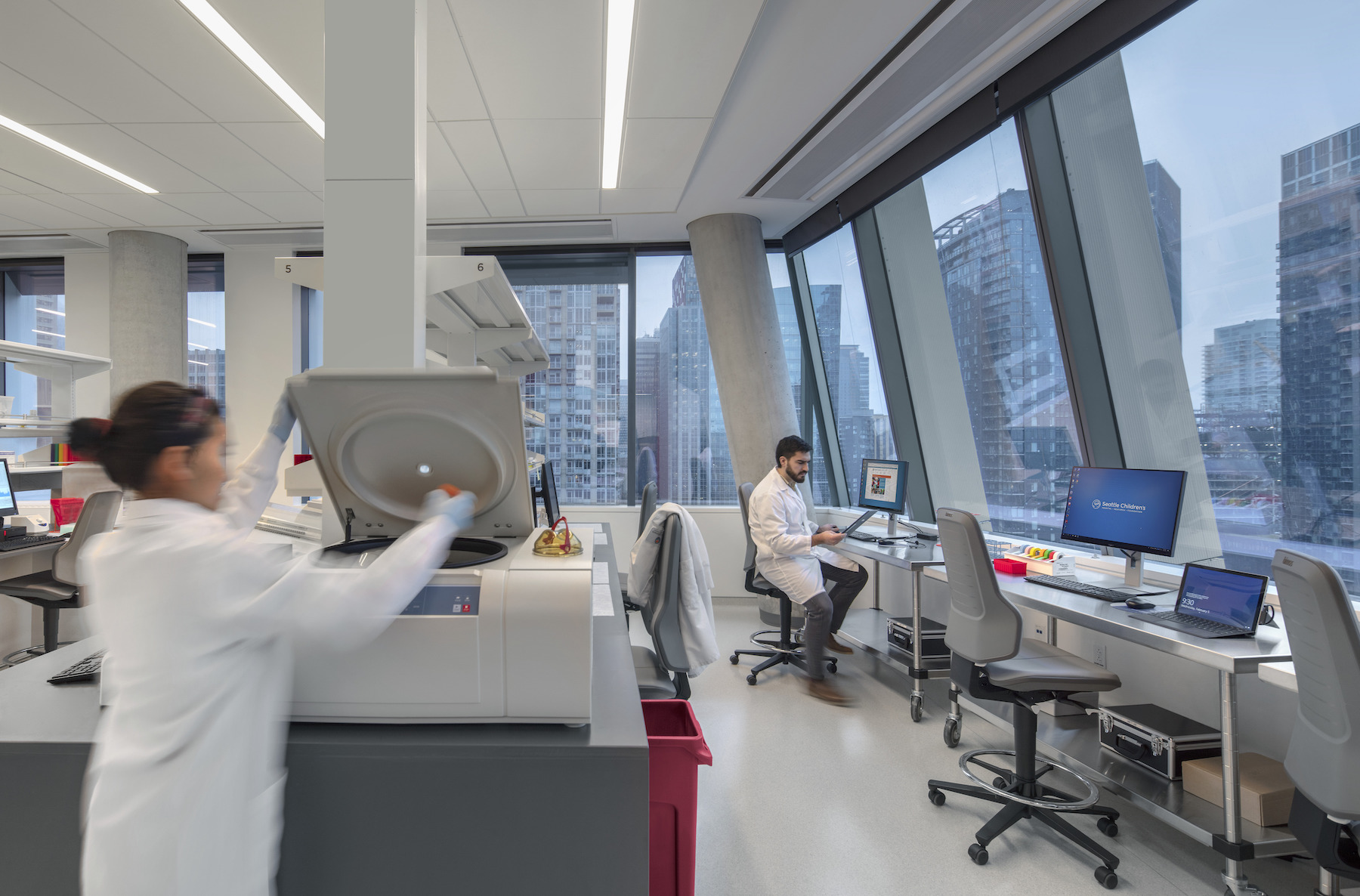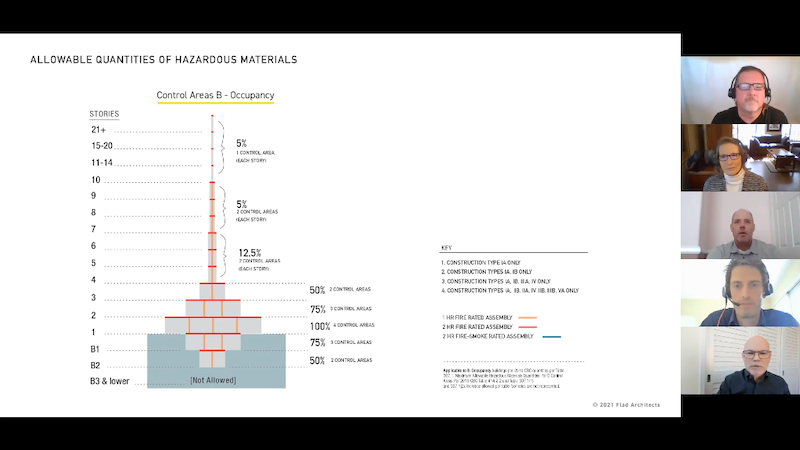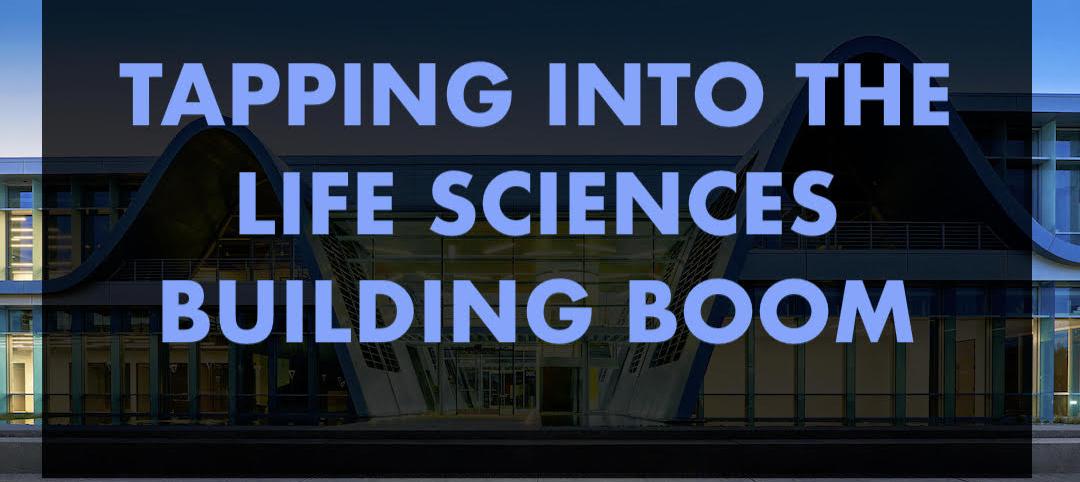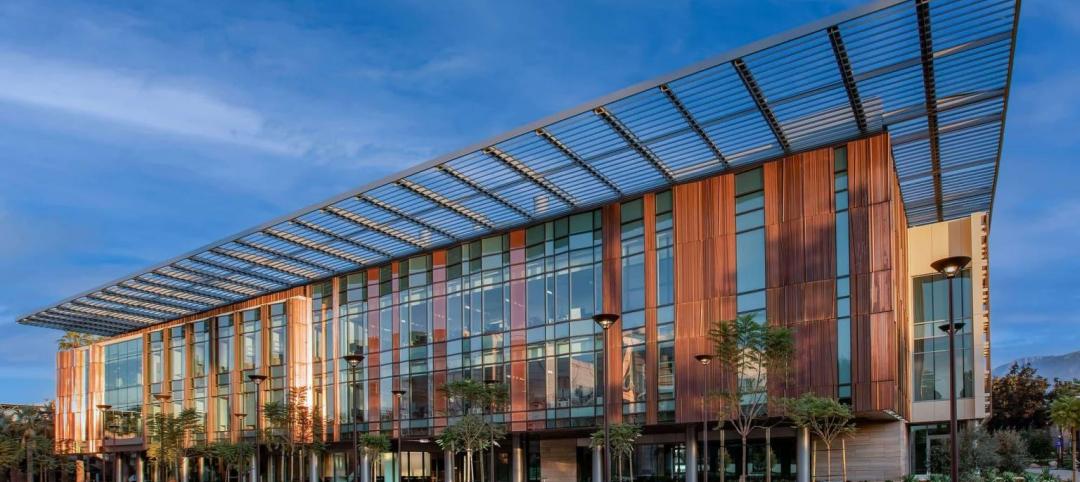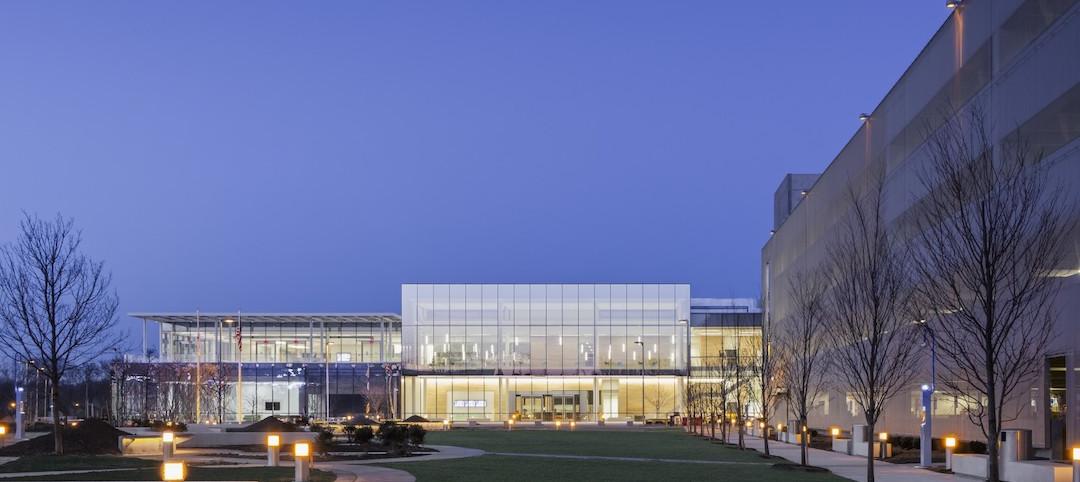While the birth of the high-rise building can be traced back to the late nineteenth century, designing high-rise buildings for the purpose of science remains a relatively recent concept. Historically operating outside of the urban context, traditional laboratory facilities have often been characterized by industrial and warehouse districts far removed from the public realm.
But unprecedented technological acceleration towards the end of the twentieth century—coupled with explosive growth in the biotechnology and pharmaceutical industries—sparked an evolution where research corporations began seeking more interconnected, urban locations to house their workforces and scientific operations. The high-rise science building of today represents this industry-wide shift as these facilities increasingly break away from their once-siloed counterparts—responding to a variety of socioeconomic and environmental demands—and fully integrate within the existing cultural fabric of the modern metropolitan landscape.
A NEW ERA OF HIGH-DENSITY DESIGN
Since the 1960s, global urbanization rates—the amount of people gravitating toward urban locations—has continued to gradually rise, with research suggesting 2007 may have been the turning point where more of the population lived in urban regions versus their rural counterparts. Now coined as a megatrend by the United Nations, global urbanization rates continue to rise and are expected to shift from 53 percent to 70 percent between 2020 and 2050.
As the number of people moving into already populated urban districts increases, so too, does the demand for housing and commercial real estate. High-rise facility design has proven a practical solution given the constraints of densely populated urban typology and limited options for lateral expansion. But beyond the context of real estate, life science corporations stand to reap a wide variety of additional advantages associated with urban settings and their respective amenities—including economic impacts and talent accessibility, cultural engagement, and enhanced environmental impact—historically unavailable given the distant locale of traditional laboratory operations.
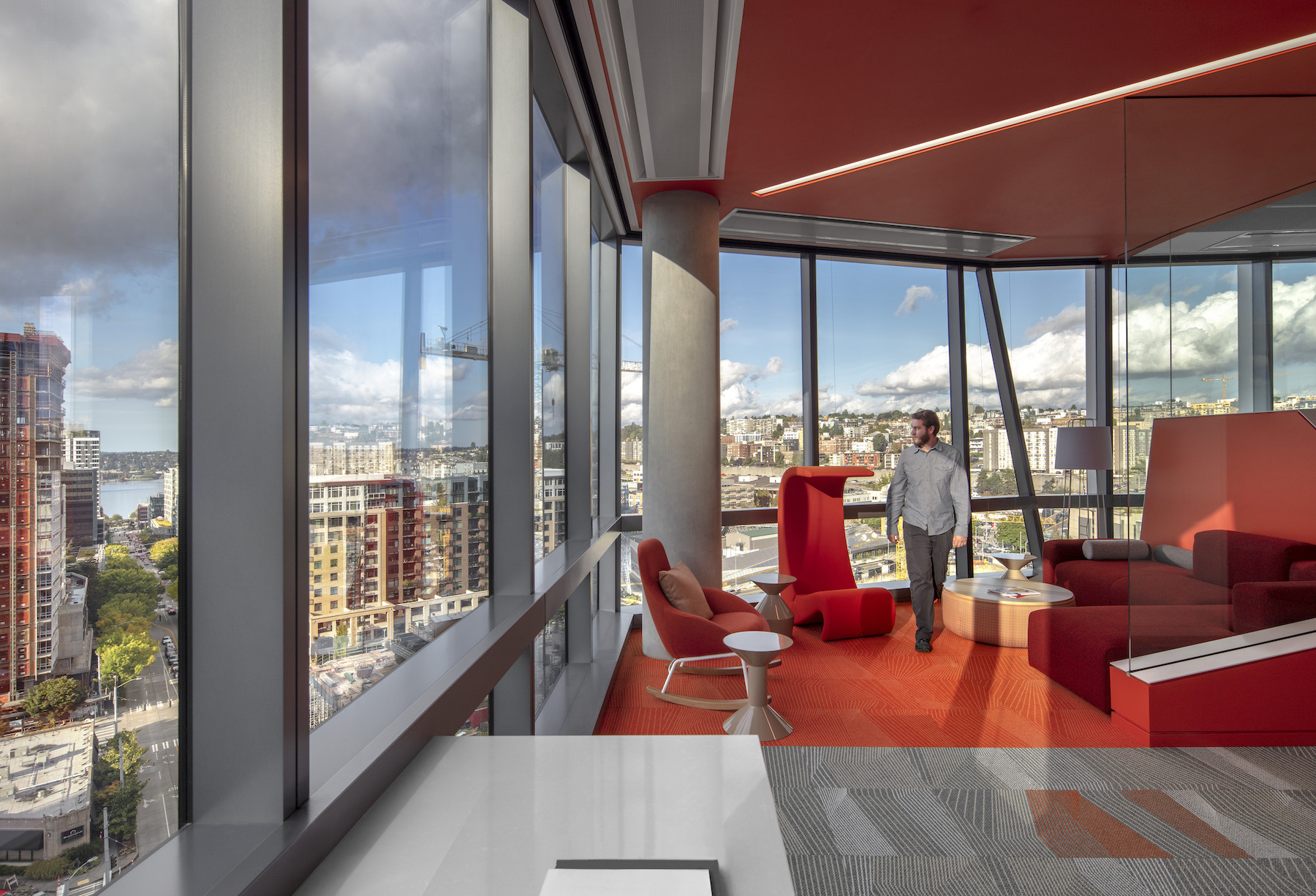
Access to daylight, views of the surrounding urban landscape, and bold color bring the scientific community together for collaboration and inspiration at the Seattle Children’s Research Institute. Photo: Bill Timmerman, courtesy Flad Architects
Economy
By expanding upward, companies offset associated costs incurred with corporate relocation efforts while simultaneously maximizing their existing land value. Positioning themselves within an urban context greatly improves talent accessibility and outreach. A prime example, South San Francisco—as one of the most prominent international biotech hubs of today—highly benefits from proximity to top-rated academic institutions, including Stanford University, UCSF, and UC Berkeley. Through strategic location selection, life science organizations are perfectly positioned to establish academic partnerships and recruit top talent from graduating classes and newly emerging professionals.
Engagement
Densely populated city settings are traditionally known as epicenters for the progressive arts, cultural and community-based activities, local businesses, and perhaps most importantly—urban living. Life science organizations that maintain their urban footprint can offer prospective workforces a multitude of amenities beyond the standard human resources benefits package, all within the parameters of their everyday life. Urban work environments also position staff closer to fellow industry peers for increased opportunities for collaboration and connection, often culminating in “community clusters”—micro research groups that form within the larger life science district.
Beyond internal benefits, an urban locale provides life science corporations a unique opportunity to establish reputability within the community and foster connections with the public. Seattle Children’s Research Institute’s Building Cure, for example, boasts eleven floors of biomedical laboratory and research space on a primary urban arterial in the heart of downtown Seattle, effectively contributing to a safe, lively, and user-friendly surrounding streetscape. Building Cure further maximizes public engagement through ample ground-level amenities designed to bring people together, including an in-house auditorium and the Science Discovery Lab, a next-generation science classroom for students.
Collaborating with local architect Aedas, a key design decision was made to push core elements—such as stairs and elevators—to the far ends of the building, clearing the center for enhanced flexibility in designated research areas. This layout provides hyper-flexible floorplates and an advanced platform for scientific discovery capable of adapting to evolving program needs. This configuration strategy has also resulted in greater program transparency—utilizing the staircase as a visual gateway into the science taking place on each floor—further translating the interdisciplinary nature of scientific buildings into the external community. Ultimately, the overall facility planning fosters rapid cross-pollination for interactive research communities that respond to agile scientific discoveries, helping accelerate the delivery of successful cures.
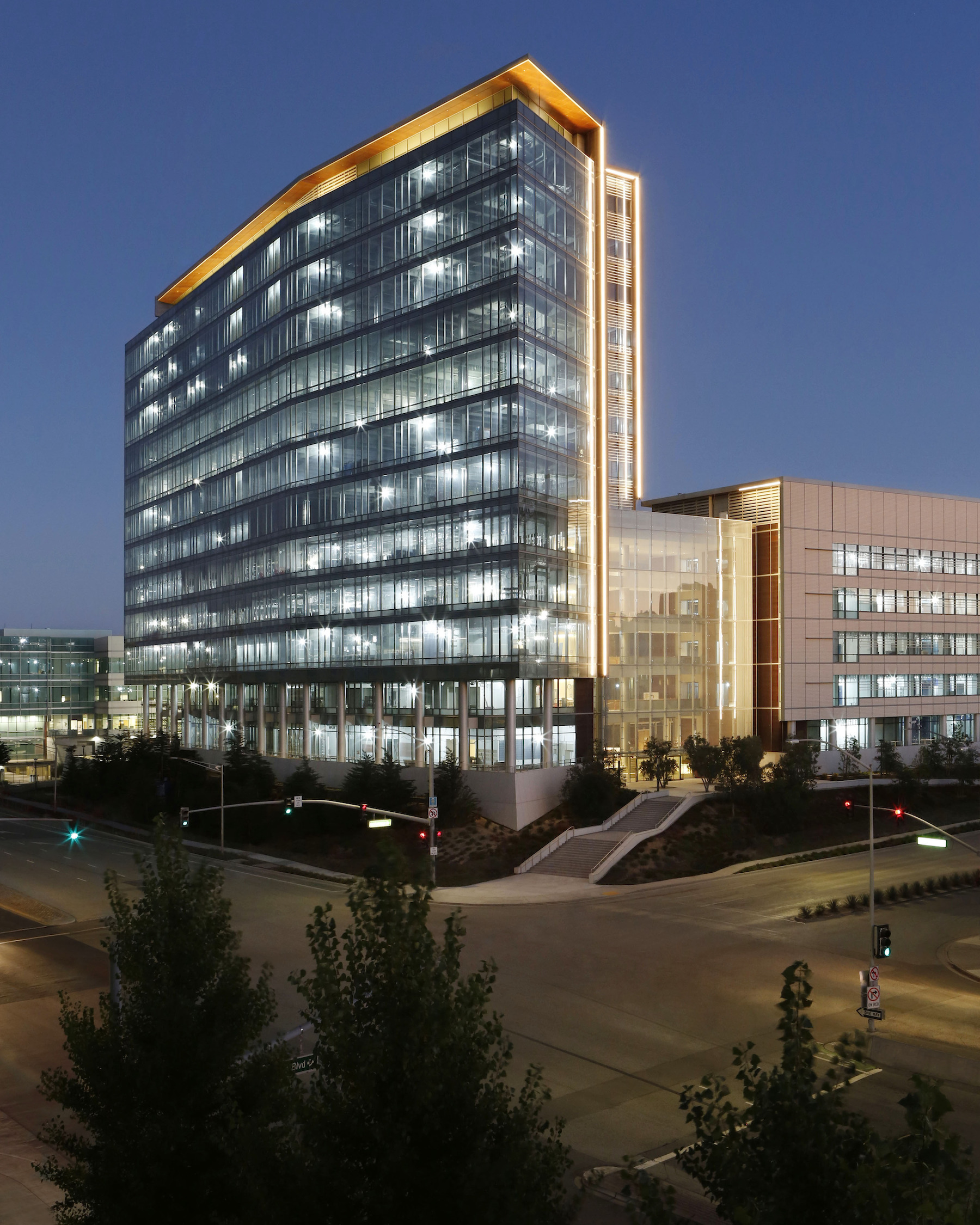
Gateway of Pacific's iconic, 12-story tower marks the beginning of BioMed Realty's multi-phase effort to establish a beacon for world-class research and development while creating a new front door into South San Francisco's booming biotech metropolis. Photo: Daniel Peak Photography, courtesy Flad Architects
Environment
Perhaps the most significant advantage of high-density design in the life science sector relates to the positive correlation between enhanced economy and community engagement and its impact on the environment. Maximizing land value and building upward keeps life science corporations within the parameters of city amenities, such as accessibility to public transit, reducing reliance on carbon-emitting automobiles. In addition to reducing overall environmental impact, corporations that are located close to public transit can help contribute to enhanced public health by encouraging physical activity as a primary commuter mode.
Echoing this correlated overlap, BioMed Realty’s prominent Bay Area life science campus—Gateway of Pacific—carefully demonstrates the holistic value that can be achieved through the high-density approach. Introducing a new style and vision of an interconnected campus, Gateway of Pacific effectively transforms a once-underutilized commercial development slightly offset from the larger city context into a vibrant, multi-phase, multi-use life science community within South San Francisco's biotech corridor.
Redeveloped from the ground up, Gateway of Pacific is designed to attract life science tenants and top talent from across the globe. Creating its own community within a city, the campus provides an advanced platform for discovery and innovation through human-centric workplace design and a variety of flexible laboratory space types to accommodate fluctuating tenant, client, and research needs. To meet the elevated expectations characteristic of South San Francisco's biotech district and clientele, the comprehensive campus boasts all the amenities associated with urban living, including culinary, fitness and outdoor recreation, and opportunities for social engagement.
Further echoing the campus' contributions to the community at large, all phases fully maximize their respective site locations, incorporating a variety of sustainable design elements such as on-site energy generation from photovoltaic panels, rainwater capture, grey water collection, and high-efficiency heating and cooling. All phase buildings are designed to achieve high sustainability goals; the phase one complex and amenity building have both achieved LEED Platinum.
A Holistic Approach
Given the cultural conveniences gained as well as corporate opportunities outlined above, the life science industry has boldly embraced this ever-evolving era of high-density design. But despite the excitement of flourishing biotech ecosystems and the potential for life science discovery, the success of these facilities is dependent on utilizing a holistic architectural approach that not only carefully balances key urban planning principles with client requirements but also effectively addresses and navigates the many complexities and highly specialized technical requirements associated with high-density design for laboratory environments.
Watch On-demand: Science in the Sky webinar, hosted by Flad Architects
Increasing global urbanization rates. Navigating densely populated urban typology. Advancing public health and reducing environmental impact. Paving a path for future scientific innovation and continued progress. These critical ideas dominated a recent virtual roundtable to explore the impacts and opportunities of high-rise building design for the purpose of advancing science. This on-demand webinar was moderated by Flad Principal Joseph Marshall. Panelists included Jared Byrne, Director of Master Planning Strategy at Amgen; Russ Drinker, Director of West Coast Science & Technology at Flad; Dr. Sylvia Darr, Principal at Flad; and James Falconer, Principal at Affiliated Engineers. Watch on demand.
Designing successful high-density facilities for science requires unparalleled knowledge in complex pharmaceutical and biotechnological research and development operations as well as an intricate understanding of applicable code requirements and best practices, including the International Building Code and California's Group L-Occupancy Laboratory Suites classification. These building codes are instrumental in maintaining the health and safety of all facility occupants, the surrounding community, and emergency responders, and thus paramount in all projects.
Looking to the future
The evolution of high-density design marks an extraordinary industry turning point that allows us to reimagine traditional laboratory settings and create dynamic, human-centric buildings that carefully express the robust urban planning principles of life science environments, respond to unique corporate cultures, and successfully integrate into their respective communities. During an era of historic scale when perhaps life science innovation has never been more important, our ability to design and successfully infuse effective, technically advanced high-rise research facilities into the metropolitan landscape is an enormous opportunity for continued discovery that further enables us to tackle the grand challenges of our time.
Related Stories
University Buildings | Jan 11, 2022
Designing for health sciences education: supporting student well-being
While student and faculty health and well-being should be a top priority in all spaces within educational facilities, this article will highlight some key considerations.
Giants 400 | Dec 31, 2021
2021 Science and Technology Sector Giants: Top architecture, engineering, and construction firms in the U.S. S+T facilities sector
HDR, CRB, Jacobs, Skanska USA, and Whiting-Turner Contracting Co. top the rankings of the nation's largest science and technology (S+T) sector architecture, engineering, and construction firms, as reported in the 2021 Giants 400 Report.
Laboratories | Nov 18, 2021
Tapping into the life sciences building boom
Paul Ferro of Form4 Architecture discusses how developers are pivoting to the life sciences sector, and what that means for construction and adaptive reuse.
2021 Building Team Awards | Nov 17, 2021
Caltech's new neuroscience building unites scientists, engineers to master the human brain
The Tianqiao and Chrissy Chen Institute for Neuroscience at the California Institute of Technology in Pasadena wins a Gold Award in BD+C's 2021 Building Team Awards.
Laboratories | Nov 17, 2021
New report finds a biopharma industry being reshaped by disruption
Industry respondents to CRB’s survey weigh in on project delivery, digitization, and off-site manufacturing for life sciences construction.
Laboratories | Oct 14, 2021
‘Next-generation’ Quest Diagnostics lab unveiled in New Jersey
Mark Cavagnero Associates designed the project.
Laboratories | Aug 31, 2021
Pandemic puts science and technology facilities at center stage
Expanding demand for labs and life science space is spurring new construction and improvements in existing buildings.
Giants 400 | Aug 30, 2021
2021 Giants 400 Report: Ranking the largest architecture, engineering, and construction firms in the U.S.
The 2021 Giants 400 Report includes more than 130 rankings across 25 building sectors and specialty categories.
Laboratories | Aug 25, 2021
Lab design strategies for renovations and adaptive reuse
Lab design experts in HOK’s Science + Technology group outline the challenges organizations must understand before renovating a lab or converting an existing building into research space.
Architects | Aug 5, 2021
Lord Aeck Sargent's post-Katerra future, with LAS President Joe Greco
After three years under the ownership of Katerra, which closed its North American operations last May, the architecture firm Lord Aeck Sargent is re-establishing itself as an independent company, with an eye toward strengthening its eight practices and regional presence in the U.S.


